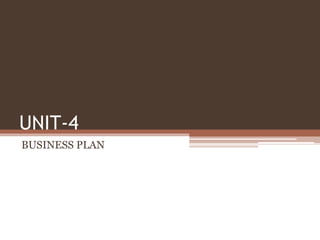
Business plan format
- 2. DEFINITION • Mar J. Dollinger has defined the business plan as “the formal written expression of the entrepreneurial vision, describing the strategy and operations of the proposed venture.” • A business plan is a formal written document that describes the strategies and opportunities of a proposed venture. It contains current status and projected results of the new business.
- 3. Importance of Business Plan • Financial Blueprint • Reduce errors • Attract stake-holders • Guide to decision making and judgment
- 4. Objectives of a Business Plan • To give direction to the vision of Entrepreneur • To objectively evaluate the future prospects of the business To monitor the progress after implementation of the plan • To seek loans from Financial Institutions To facilitate the decision making process To persuade others to join the business • To identify strengths and weaknesses present in the internal environment To identify opportunities and threats in the external environment • To assess the feasibility of the business
- 5. Contents OF Business plan • Executive Summary • Details of Executive Summary • Mission • The Company • The Business Competition • Management Team • Capital Requirements • Financial Projections • The market
- 6. Aspects of Business Plan
- 7. Financial Aspects: • Purpose of financing:whether the funds are required for modernisation, working capital, expansion or diversification or for research and development. • Amount of Investment :The capital structure, projected growth, investment in fixed assets and intangible assets, advertising and marketing expenditure and working capital expenses, R&D expenses should be added.
- 8. Financial Aspects • Capacity: Here capacity means cash flow and the firm’s ability to meet its regular financial obligations and to repay loans. • Plans for repayment: An important element of the loan or investment proposal is the repayment schedule or exit strategy. The entrepreneur should also include the exit strategies if the company fails in successful operations.
- 9. Financial Aspects • Financial projections: The company should include all the financial statements like cash flow statements, fund flow statements, profit and loss account, balance sheets, break-even analysis and statement of assumptions of the previous years
- 10. Marketing Aspects of Business Plan: • Market segment: The BP should contain information relating to how the market is segmented or differentiated. • Pricing: The pricing policy should be clearly defined. The company should state whether the products are priced based on market price, cost price, gross profit objectives, or perceived • value.
- 11. Marketing Aspects of Business Plan: • Promotional strategies: It is the modern way to market the products. In this stiff competition there is a need for using promotional strategies like cash backs, reward points, free after sale services, guarantees and warrantees, discounts and coupons etc • Research and Development: The company should concentrate on R&D constantly to modify and update the products regularly so that it suits the targeted customers in long run.
- 12. Marketing Aspects of Business Plan: • Distribution Channels: It is the most important part. Distribution channel play a significant role in reducing the cost as well as reaching the target customers quickly. Ex Wholesaler, retailer, factory outlets, exclusive online sale, door to door selling, agency selling, chain link selling etc., must be described clearly.
